My favourite part of the legislative calendar in Prince Edward Island is the “consideration of the estimates,” a line-by-line review by Members of the Legislative Assembly of the Estimates of Expenditure and Revenue. The Clerk tells me that this exercise is increasingly uncommon in other jurisdictions; I’m happy it’s one that Prince Edward Island has held onto, as the questions from the opposition on government’s spending and revenue often shed interesting light on how and what government is doing, and provide a useful set of critical eyes on an operation that can always benefit from it, no matter the government of the day.
I sat in on the consideration of the estimates for the Department of Agriculture and Fisheries yesterday, and I was immediately struck by the degree to which the process remains unelevated by the gifts afforded by digital technology: every question to the Minister was followed by a flurry of page-turning in the marked-up binder he used to guide him, and while he did a creditable job making his way, many questions remained unanswerable, at least immediately, because the answers were filed elsewhere.
This got me thinking that, through the transformative powers of HTML, we could make the Estimates of Expenditure and Revenue a much more navigable guide simply by linking it, internally and externally, with relevant information, information that might even obviate the need for the opposition to ask questions in some cases because the answers would be self-evident. In other words, we could avoid back-and-forths like this (from April 20, 2016):
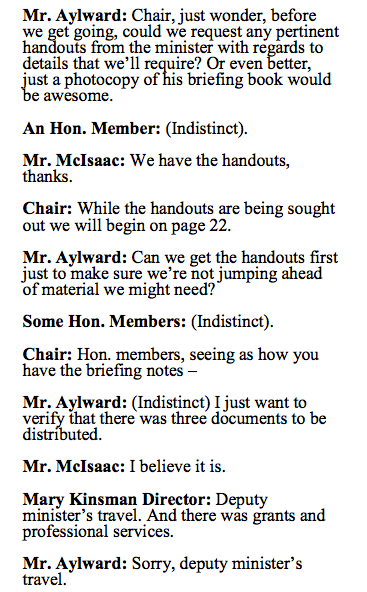
and this:
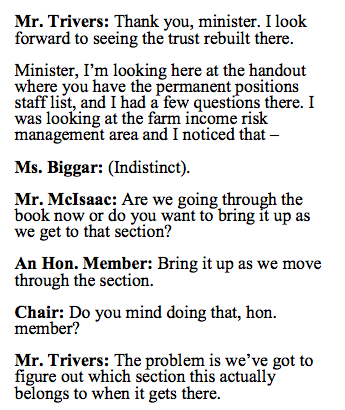
and this:
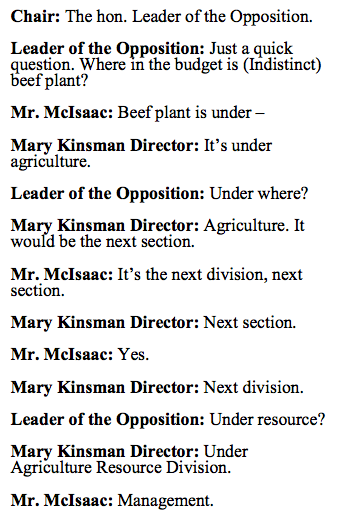
These are all examples of process bottlenecks that could be solved by better information management: a well-indexed, hyperlinked, intelligent Estimates of Expenditure and Revenue web resource would connect the otherwise disconnected dots and allow members to concentrate their discussions on substantive issues, not on “what section is that under?” questions.
Here’s a simple example, of more utility to we the people than to legislators, but one that illustrates what I’m thinking about. Page 10 of this year’s Estimates of Expenditure and Revenue is a table titled “Expenditure Summary by Department” that, in essence, says “here’s how we spend our money.” It’s a high-level summary broken down by department and agency that shows the current budget’s estimate and the previous budget’s estimate and forecast. In the PDF the government releases, it looks like this:

The line items in the first column are an excellent candidate for hyperlinking. Converting the table to HTML (a non-trivial process at present as the structure of the PDF is labyrinthine), it’s then easy to make each department and agency a link to a page on the government website:
| 2016-2017 Budget Estimate |
2015-2016 Budget Forecast |
2015-2016 Budget Estimate |
|
|---|---|---|---|
| CURRENT | |||
| Agriculture and Fisheries | 32,965,200 | 34,147,300 | 34,726,200 |
| Communities, Land and Environment | 20,728,600 | 19,913,500 | 20,526,200 |
| Economic Development and Tourism | 1,137,800 | 1,092,700 | 1,187,100 |
| Innovation PEI | 32,203,100 | 33,294,400 | 25,078,100 |
| Tourism PEI | 13,609,100 | 13,454,400 | 13,727,500 |
| Education, Early Learning and Culture | 250,979,300 | 245,184,600 | 243,711,900 |
| Island Regulatory and Appeals Commission | 1,200,300 | 1,200,300 | 1,200,300 |
| Executive Council | 7,244,300 | 7,098,100 | 7,334,200 |
| Family and Human Services | 96,808,400 | 95,661,200 | 94,205,200 |
| Finance | 73,852,200 | 69,525,900 | 71,886,000 |
| Council of Atlantic Premiers | 188,400 | 188,400 | 188,400 |
| Employee Benefits | 60,138,400 | 60,612,300 | 55,429,900 |
| General Government | 10,300,000 | 4,837,000 | 6,300,000 |
| Health and Wellness | 12,547,600 | 12,536,600 | 12,540,900 |
| Health PEI | 604,664,100 | 592,843,000 | 586,431,600 |
| Justice and Public Safety | 52,541,700 | 48,938,000 | 49,290,300 |
| Transportation, Infrastructure and Energy | 111,688,600 | 104,672,200 | 108,993,600 |
| Interministerial Women’s Secretariat | 438,600 | 438,600 | 438,600 |
| Workforce and Advanced Learning | 120,690,000 | 121,498,000 | 121,831,000 |
| Employment Development Agency | 5,231,500 | 5,206,500 | 5,231,500 |
| Auditor General | 2,028,800 | 1,911,200 | 2,056,700 |
| Legislative Assembly | 5,992,100 | 6,422,800 | 6,422,800 |
| PEI Public Service Commission | 7,344,700 | 7,182,100 | 7,320,000 |
| PROGRAM EXPENDITURE | 1,524,522,800 | 1,487,859,100 | 1,476,058,000 |
| Interest Charges on Debt | 126,698,100 | 127,966,400 | 127,016,400 |
| Amortization of Tangible Capital Assets | 68,600,700 | 66,500,300 | 65,671,100 |
| TOTAL EXPENDITURE | 1,719,821,600 | 1,682,325,800 | 1,668,745,500 |
It would be easy to add intelligence to the estimates so that hovering over any number would provide some additional insights, like (this non-functional mockup):

Looking under the hood of the Estimates of Expenditure and Revenue PDF file reveals, via metadata, that essentially the same document flow has been in place since fiscal 1996-1997:
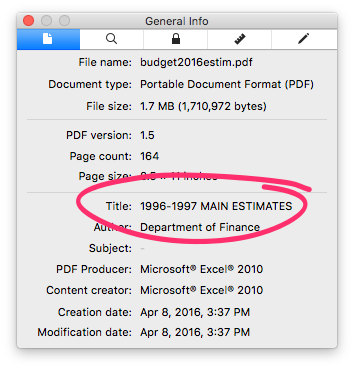
In the intervening 20 years we’ve learned so much about how to make information more useful by making it more linked, more navigable, more like a node in a network than an paper enclave.
I move (am I allowed to make motions here?) that for the next fiscal year we set ourselves the goal of crafting a thoroughly modern version of the estimates.
As reported earlier, Premier MacLauchlan generously offered me a ride to Summerside last night for the Learning Partners Advisory Council meeting.
While I don’t believe there are any formal rules governing the reporting of such adventures, common sense would dictate that the discussions that took place during the ride are covered under a cone of silence.
And so if, say, the Premier accidentally revealed his plans to take PEI out of Confederation1, discretion would suggest I not mention it here.
So I will limit my colour commentary to this: the Premier drives a late model SUV that, as is custom these days, has a mid-console display screen. For most of our trip the radio was turned to CBC Prince Edward Island, 96.1 on the FM dial. And yet the station identifier appearing on the display was “Kicks96.”
I found this quite bothersome and wondered how such a thing might happen.
The most prominent radio station I could find using the “Kicks96” nom de plume is WQLK-FM which broadcasts from a transmitter in Richmond, Indiana, like CBC PEI, on FM 96.1.
I imagine there could be several ways that the Premier’s car stereo could come to think of FM 96.1 as Kicks96. Perhaps the vehicle was assembled in range of Richmond, and the radio station presets setup there? Perhaps the radio itself was manufactured in the area? Perhaps the stereo grabs its presets from some sort of web service that got confused during the update? Perhaps the Premier is also secretly the Governor of Indiana?
I called Kicks96 in Richmond, IN and spoke to a helpful receptionist who transferred me to an equally helpful production manager for the station. He confirmed there were no automobile assembly plants in the area, no formal arrangements with the Premier’s automobile manufacturer to pre-install Kicks96 on the stereo (although he wished there were). He mentioned that there were several other radio stations in the US that used the “Kicks96” tag, and the clues might be found there instead of in Richmond. His best guess, and it was a long shot he said, is that when the radio station presets were installed it may have been at night when, due to “skipping”, the Indiana signal reached all the way to PEI.
I tried to call CBC Prince Edward Island, but all branches on their telephone tree lead to voicemail, and there’s no “Press 7 to ask Kenny Adams questions about FM propagation” option.
At this hour, thus, the Kicks96 mystery remains a mystery.
Otherwise, the ride was pleasant; we were joined by the Learning Partners Advisory Council co-chair Bill Whelan, and had a good chat, there and back.
You will be happy to learn that we did have a chance to speak briefly about Gross Fixed Capital Formation and related issues, and my newfound ability to speak somewhat intelligently about the GDP stood me in good stead.
The Island will be well-positioned when we join our Icelandic cousins in a new Confederation. Oops, I wasn’t supposed to talk about that. was I.
I owe the Premier a solid for the ride; maybe next time I’ll drive.
So remember yesterday when I was chickening out of asking Premier MacLauchlan for a ride up to Summerside? Well my chickening out was genuine, but what I didn’t factor in, somewhat naively, is that the Premier would find out about my chickening out and offer me a ride anyway.
Which, of course, this being Prince Edward Island and all, he did.
Last night while [[Oliver]] and I were out at the John Cousins, Catherine answered the phone at home; the caller inquired as to whether I had a ride to Summerside or not, and when Catherine said she didn’t know, the caller left their name and number and asked her to have me to call them back when I got in. The caller was Premier MacLauchlan.
Which makes it doubly important that I have a deeper understanding of Prince Edward Island’s Gross Fixed Capital Formation because, you gotta know that, with the way things are going, the Premier is actually going to ask me about it.
I first became aware of the very notion of Gross Fixed Capital Formation only yesterday, while reading the province’s Annual Statistical Review (a document that should be on the bedside of every Islander). Here’s what it says in the economic overview for 2012-2013 (emphasis mine):
Growth between 2012 and 2013 was largely the result of a 4.5 per cent increase in exports. Final domestic demand increased 1.8 per cent, while household consumption expenditures increased 1.6 per cent. Government gross fixed capital formation increased by 3.7 per cent. Imports increased by 1.8 per cent. Real gross domestic product growth was revised up for 2011 to 1.6 per cent and revised down for 2012 to 1.0 per cent.
In regular peacetime reading, I would translate this, roughly, as “blah blah blah, blah blah, blah.”
But these are not regular times. I needed help.
Who better to ask about what all this means, and why we measure it, than the province’s Director of Economics, Statistics and Federal Fiscal Relations, Nigel Burns, an estimable man to whom I’ve addressed similar questions in the past and always received a thorough and helpful answer.
So I called Nigel up. And here’s what I learned.
The summary that appears in the overview I quote above (“increased by 3.7 per cent”) uses numbers from a Statistics Canada-provided table that appears on page 53 of the Annual Statistical Review titled “Real Provincial Gross Domestic Product, 2009-2013 (Millions of Chained (2007) Dollars) Prince Edward Island”. Here’s the table, with the “Government gross fixed capital formation” highlighted:
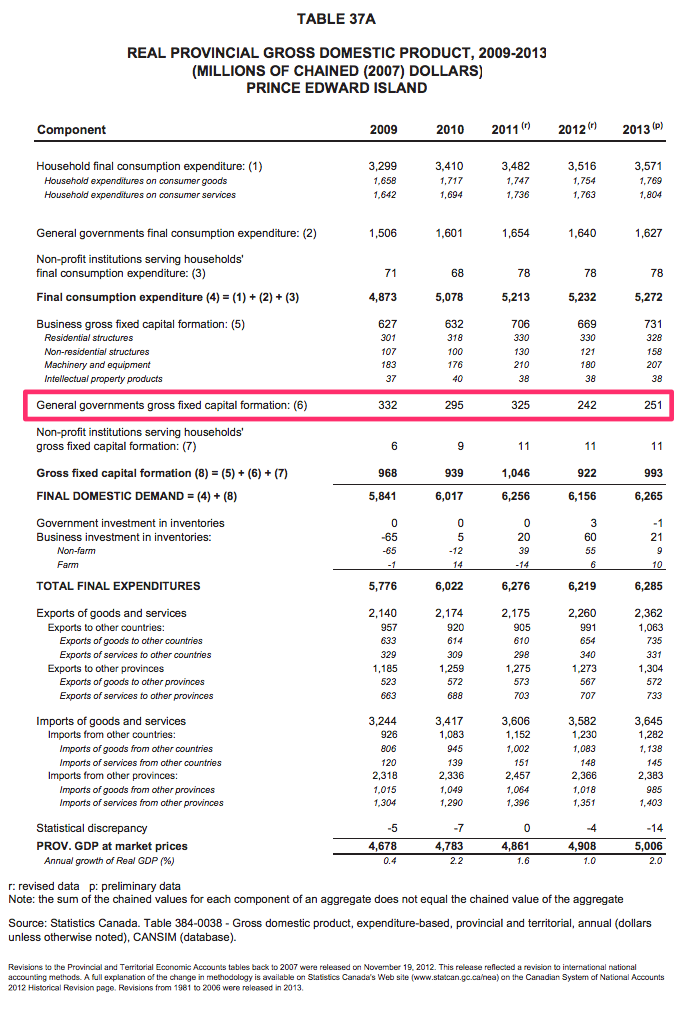
The “3.7 per cent increase” referenced in the overview is the increase of $242 million in 2012 to $251 million in 2013 in the last two columns of the highlighted row above.
Breaking this down, with Nigel’s help, here’s what this means.
This table reports on the Real Gross Domestic Product of the province (often referenced as “the GDP”); this, Statistics Canada says, is a report of the “total value of the goods and services produced” in the province. You calculate it by adding up everything spent on stuff (roads, laundry detergent, schools, olive oil) and adding this to the difference between exports and imports.
So in 2013, for example, we spent $6,285 million on stuff; add this to the difference between exports and imports of -$1,283 million and you get a GDP of $5,006 million.
In rougher numbers: $6.3 billion spent, minus $1.3 billion in import/export difference, equals $5 billion in GDP.
The Gross Fixed Capital Formation part of this is the portion of the “stuff” that is fixed: roads, houses, schools, buildings, bulldozers, photocopiers, hammers (as opposed to, say, cable TV, mayonnaise, and toothpicks).
And the Government Gross Fixed Capital Formation is the portion of that which is spent by governments (federal, provincial and municipal).
So, in other words, in 2013 the federal, provincial and municipal government on Prince Edward Island spend a combined $251 million on “fixed stuff.” They built schools. Bought snowplows. Built a wharf. Dug some ditches. Add it all up and it cost them a quarter billion dollars.
As it happens, the “Millions of Chained (2007) Dollars” part of the table means that governments didn’t actually spend $251 million on fixed stuff in 2013 on Prince Edward Island, they spent $251 million in 2007 dollars on fixed stuff in 2013. Converting the numbers to 2007 dollars removes inflation from the numbers, and allows apples-to-apples comparisons to be made.
I asked Nigel why we’d measure government gross fixed capital formation at all — what does it tell is, from a policy-making perspective? — and he told me that, in part, it gives us an indication of the involvement of governments in the economy. If, for example, there was a 20% decrease in government gross fixed capital formation from one year to the next, this would tell us, in essence, “wow, governments really pulled back on investments in infrastructure last year.”
And as a component of the GDP it allows us to see what role government spending on fixed stuff plays in the larger shape of the economy.
As it happens, most of the macroeconomic things you hear the Premier and his ministers talking about are packed into that table.
For example, last October the Premier gave an address to the Summerside Chamber of Commerce where he reported, in part:
My second observation on the trade front brings us close to home. Prince Edward Island has a balance-of-trade deficit that hobbles our economy. Simply put, we buy more than we sell. On an annual basis, we spend $1.3 billion more in purchases from outside the province than we generate in receipts from out-of-province sales. While we can be deservedly proud of our expanding export story, our province will not be geared for sustainable growth unless we can shrink that balance-of-trade deficit. It currently represents more than 20% of our total GDP.
The story he told in that paragraph is also told in the GDP table: the “exports of goods and services” number is $2.3 billion and the “imports of goods and services” number is $3.6 billion. So we’re importing $1.3 billion more than we’re exporting.
Or when the Minister of Education, Early Learning and Culture said, in the Legislative Assembly, on April 14, 2016:
The next area of my responsibility, and something that I’m becoming very interested in and learning a tremendous amount, is the area of culture. The culture sector contributes $121 million to our local GDP.
That’s $121 million that appears in various places in the “expenditures” section of the table — theatre tickets, musical instrument purchases, and so on. It seems like a lot, but when you take $121 million as a proportion of the total provincial expenditures of $6,265 million, it turns out to be only 1%. An important 1%, of course – the soul of the province, you might say – but only 1% nonetheless. And if you’re trying to move the GDP, perhaps not where you’d put a huge amount of emphasis if you want to make big gains. Which is both important to understand, and also important, as a way of thinking, to confront.
Peter Bevan-Baker, Leader of the Third Party, released a briefing document when he introduced the Well-being Measurement Act in the Legislative Assembly last fall that nicely summed up the need to confront this:
- Traditional methods of determining progress such as Gross Domestic Product and Gross National Product measure production and consumption.
- These systems do not measure the effects of production and consumption on society, the economy and the environment. They do not measure quality of life of a place, or the wellbeing of its people.
- By using only economic measurements like GDP, Prince Edward Island remains at risk of failing to meet the needs of its residents, struggling to develop a sustainable economy, and not being able to meet the environmental challenges that are ahead.
Which is to say, I think, that it’s all very well and good to increase the GDP, but what if increasing the GDP decreases the qualities of some of the things in our lives that we value? At the very least, shouldn’t we measure those things so that we can understand the rise and fall of the GDP in a more human, day to day context?
I’m intrigued by that notion.
And also embarrassed to find that, after hearing the term GDP batted about in the media for 50 years, it wasn’t until today that I opted to find out what it really means.
So, that’s a lot to talk about on the car ride to Summerside now, isn’t it.
One of my favourite passages in the biography of former Prince Edward Island Premier Alex B. Campbell written Hon. Wade MacLauchlan just before he became Premier himself:
Campbell went on to build good relationships with NFU leaders. Wayne Easter recalls one meeting “at which we had given the premier shit likely,” after which Campbell offered to drive him back to his truck which was parked several blocks away. Easter says, “I’ve never forgotten it to this day. I was twenty-two or twenty-three. Alex was driving the car and chatting away, not about the meeting. This was quite something, driving in the car with the premier.
Premier MacLauchlan co-chairs the Learning Partners Advisory Council of which I’m a member.
We have our second meeting tomorrow night, up in Summerside, about an hour’s drive to the west. I thought seriously about asking the Premier for a ride up to the meeting, but in the end I chickened out: I’m nowhere near as fast on my feet as Wayne Easter, and I’m pretty sure I couldn’t hold my own. He’d say something like “how do you feel about our fixed capital formation for fiscal 20141” and my most considered response would be “um.”
Of course, we could just talk about seafood pie. And I’ve missed a great opportunity.
I had my own delightful encounter with Alex Campbell about 15 years ago. I was working as a new product developer for the Anne of Green Gables Store, and was sent to meet with Alex to see if he might consider selling his driftwood creations. He welcomed me to his Stanley Bridge cottage, served me a glass of lemonade or two, and we had a nice chat. No new products were secured, but it was otherwise a remarkable afternoon for a young pup like me.
Postscript: the Premier read this post, gave me a call, and offered me a ride. What a strange, wonderful world we live in.
It may not be an EGOT, but in Island terms surely it’s the closest one might come: I achieved tri-party recognition in the gallery of Legislative Assembly during a visit on April 8, 2016.
It started with Liberal Hon. Doug Currie, Minister of Education, Early Learning and Culture:
I’d also like to welcome Peter Rukavina who is in the gallery today and I’ll be acknowledging that in a statement. Peter is a very influential educational leader in the Province of Prince Edward Island and is very much part of the conversations about how we’re going to be moving our education system forward.
Next was Brad Trivers, Conservative MLA for Rustico-Emerald:
I wanted to welcome Peter Rukavina from the PEI Home and School Federation. He is a fellow web developer and systems analyst and I know he has had a big play in the Prince Edward Island systems. I’m particularly interested in how he might help lead this government towards openness and transparency with open data initiatives. That’s an area I am very interested in as well.
Next it was back to the Liberal Jordan Brown, Government Whip and MLA for Charlottetown-Brighton:
Peter Rukavina, a great community member and somebody that has been very involved in numerous different community initiatives over the years. Great to see you here.
One more Liberal, Hon. Hon. Allen F. Roach, Minister of Finance:
But I’d also like to make a note that it’s great to have Peter Rukavina here…
And then, to cap it all off, Peter Bevan-Baker, Leader of the Third Party and MLA for Kellys Cross-Cumberland:
I’d also like to welcome Peter Rukavina. His work on home and school, of course, is legendary. Also, he’s a great advocate of open data. A large portion of the throne speech was devoted to that. So I’m sure Peter is hoping that government will follow through on that.
I should hasten to add at this point that this sort of recognition isn’t unusual for Islanders in the gallery: it’s a regular part of every sitting day, and almost anyone in the gallery will certainly be recognized.
Beyond the hyperbolic suggestions that I’m a legendary influential involved community member, it was nice to be pointed out by members of all the parties; it allows me to maintain non-partisan street cred.
For the past four summers, starting in 2012, I’ve been operating a website that provides structured data – iCal, XML, JSON, RSS – about cruise ship visits to the Port of Charlottetown, a reaction to the lack of such data from the Port itself.
Now the Port is providing data itself – not in as many formats, and missing metadata like number of passengers, but from the horse’s mouth – and so I’ll suspend my own efforts. More details here.
I’ve never known as much about the comings and goings of cruise ships as I have these past years; it’s been fun.
I was mesmerized by this building, on Lorne Street in Sackville near the Legion. Its doors and windows have been covered over in such an odd way, and shingled to match (but not). It’s like the building is holding itself hostage.
When you live on a remote planet at the edge of the galaxy as we do, it’s important to maximize time when on resupply missions.
So coffee at Smiling Goat and a new pair of Icelandic wool gloves — 25% off at Cintamani, which has a retail outlet on Spring Garden Road — and it’s off to the train home.
I’m catching the train from Sackville to Halifax for a quick 24 hour jaunt into the city for a bunch of errands. I could drive, but I am no fan of the lonely highway, and trains that nobody takes don’t keep running. So here I am.
You can’t park overnight at the Sackville VIA station, so I called the Town Hall for advice and they connected me with Rod Allen, a car dealer up the street, who generously allowed me to park there.
I arrived at the station 30 minutes early, but the time passed quickly as shortly after I arrived a woman, also early, showed up to pick up someone arriving on the train from Quebec. She turned out to be the longtime cook from Cape Jourmain, and we had a good chat.
The train arrives, the VIA app claims, in just a moment; I’ll be in Halifax for supper.
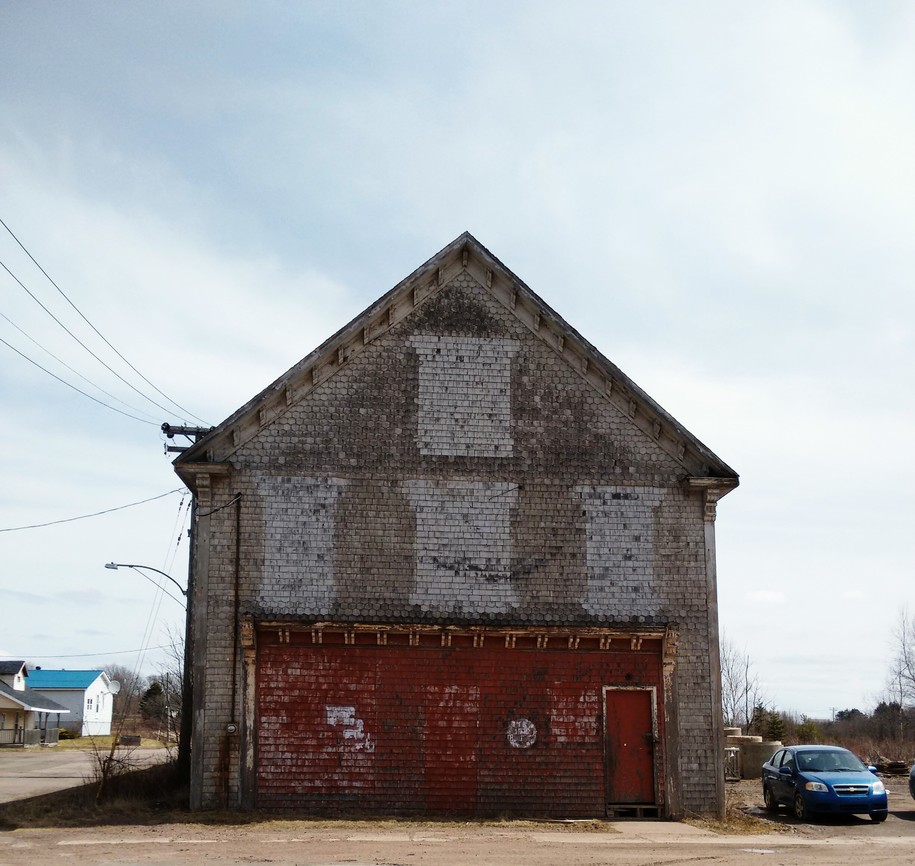

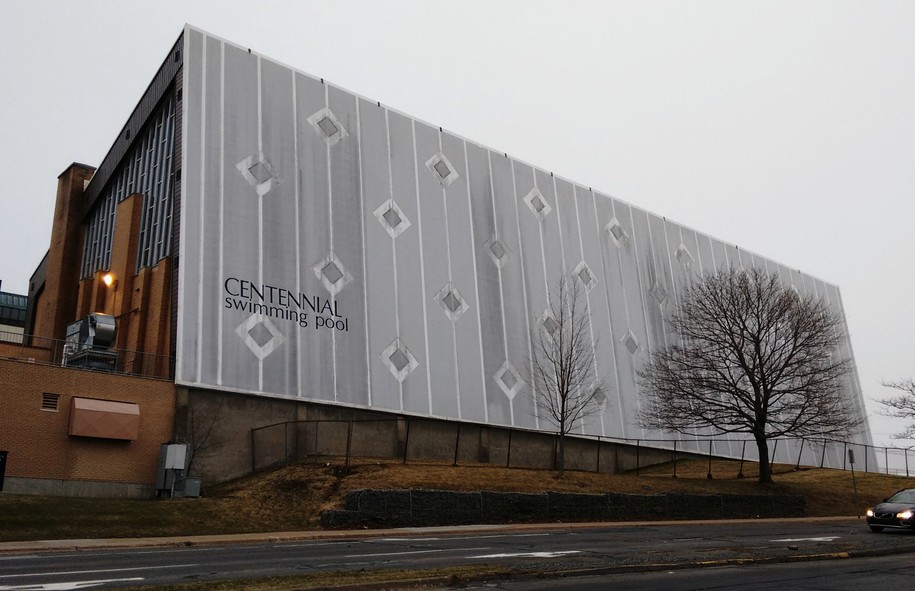
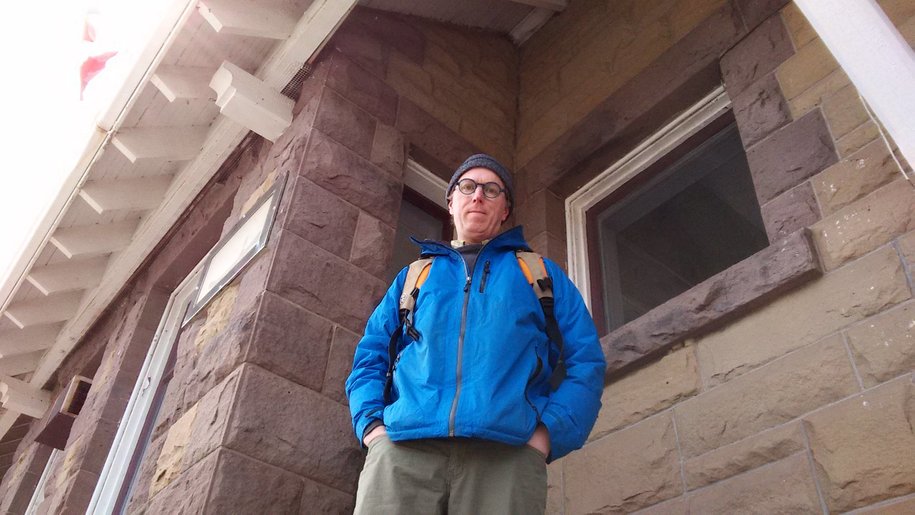
 I am
I am